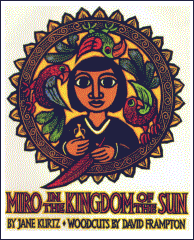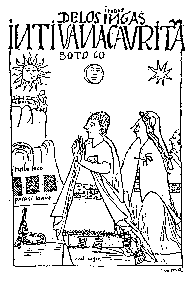
MIRO IN THE KINDOM OF THE SUN: Houghton Mifflin Co. (c) 1996, illus. by David Frampton
A re-telling of an Inca folktale. Miro sets out on a
quest to find the lake at one of the corners of the
earth so she can find the magic water to save the
prince and free her brothers.
"Frampton's strikingly bold woodcuts, filled with color and given geometric patterns and borders, are the perfect complement to this tale, evoking the magic and mystery of a vanished ancient culture....Kurtz combines formal language and a contemporary style to make the story at once accessible and otherworldly." Kirkus Reviews
"Kurtz expands on an Incan folktale, "The Search for the Magic Lake," casting it in the dignified, almost reverent prose of a high fantasy quest tale. Frampton's tinted woodcuts, rugged and bold befitting Miro's adventures, incorporate intricately patterned motifs from Incan art in strong and rugged earthtones." The Bulletin of the Center for Children's Books
"Throughout, Kurtz deftly weaves in details of pre- Conquest Inca life, giving readers a glimpse of a vanished culture as well as a good story. An excellent choice for children ready to go beyond Western fairytale favorites." Publishers Weekly
"Kurtz is a superb storyteller....an unusual and outstanding offering." School Library Journal
MIRO is on the 1996 America's Book Award Commended List
--Compare this version of the folktale with "The Search for the Magic Lake" by Genevieve Barlow in Latin American Folktales (Rand McNally, 1966). The Incas loved storytelling, and they told stories of the beginning of the world and of the hacha hacha, the eastern jungle where they said a great dragon snake lived. You can read one of their stories, for example, in From Out of the Ark: Stories from the World's Religions by Anita Ganeri (Harcourt, 1996). "The Search for the Magic Lake" was told by modern-day descendants of the Incas. Because its plot is so European, we can be almost sure it was influenced by Spanish folktales that came to South America with the conquistadores.
--The mighty Inca kingdom met its doom in 1532 when
Francisco Pizarro and his Spanish soldiers seized
Atahualpa, who was the Sapa Capac Inca (the
Magnificent and Unique Inca, emperor and child of the
sun) at the time. Atahualpa offered to have a 22' by
17' room filled with sweat from the sun (gold) and
tears from the moon (silver) if Pizarro would let him
go. From all over the kingdom, the Incas streamed in
with gold and silver bowls, cups, statues, earrings,
plates, and other beautiful things. (Do you suppose
that's where the golden flask ended up?) But when the
room was full, Pizarro was afraid to release
Atahualpa. Instead, he killed the Inca king. The
Inca people were scattered over Peru, Ecuador, and
Bolivia.
Perhaps you remember a song the settlers sing in
the Disney movie Pocohontas: "The gold of Cortez, the
jewels of Pizarro/ will seem like mere trinkets by
this time tomorrow." How did what Pizarro found at
Cuzco influence what later happened in the northern
part of the American continent?
--Most of the gold from that room was melted down and made into bars to be shipped to Spain. You might want to research what kind of effect the gold had on Spain once it got there. In any case, we don't have many of the beautiful things the Incas made from their gold, anymore. But, every week, many of us see "the most precious gift" the Incas gave to the world. Can you guess what it is? You can find the answer in a book by Milton Meltzer in chapter two, "A Gift of the Inca People." Hint...the book is not Gold: The True Story of Why People Search for It, Mine It, Trade It, Steal It, Mint It, Hoard It, Shape It, Wear It, Fight and Kill for It, but that's another good book to look at when you're studying the Incas.
--How do we know what we know about the Incas? Some kind of record of a civilization is left and can be looked at, later, by people who are interested in what that civilization was like. But stories can't be dug up and looked at. Much of what we know about the Inca kingdom, we know because of the writings of Spanish people who saw its wonders--people like Father Bernabe Cobo, Pedro de Cieza de Leon, Pedro Sancho de la Hoz, and Tomas Garcilaso de la Vega. What would you write if you were describing, say, your classroom for people hundreds of years from now to know more?
--The Spanish writers described gardens of the Sapa Inca's palaces where, among the living plants, were things like flowers, llamas, mice, butterflies, foxes made of gold and silver. Garcilaso wrote about "birds set in the trees, as though they were about to sing, and others bent over the flowers, breathing in their nectar" and about corn that looked real "down to the leaves, cob, stalk, roots, and flowers."
When Jane submitted her story to the editor that bought it, there was this passage:
"Miro walked through gardens filled with golden butterflies, foxes, and rabbits. Inside the palace, she stared at the gold and silver flowers, the downy jungle birds."
What changes were made by Jane (and her editor) before the book was published?
--Here's what Jane has to say about writing about the
Inca culture. "When I was a kid, growing up in
Ethiopia, my family visited the ancient cities of Axum
and Gondar in northern Ethiopia one year. I had
always loved to read fairy tales. Now, here were real
castles and ruins! A fascination with the old, old
kingdoms of the world took root in my mind and never
left. When I write about Ethiopia, I mostly draw on my
memories (though I always check things out with
Ethiopian friends or people who've lived in Ethiopia
more recently than I have). But I had no memories to
use with the Inca kingdom. You know, you have to know
what you're writing about--if you don't know it from
first-hand experience, you have to have the passion
for doing lots and lots of reading and studying about
it. So writers usually pick things to write about
that they know well or are very interested in. That's
how it was with me. I read tons about the Inca
empire, but it never seemed a chore because of my
fascination with ancient kingdoms."
Some of the most helpful books because of their details on Inca daily life were:
--Look at another book illustrated by David Frampton, Whaling Days (Houghton Mifflin). What are some of the similarities and differences between it and MIRO? Look at some of the Inca symbols in these old pictures. You can carve one of the symbols onto styrofoam and then, using ink and a roller, create your own prints to illustrate MIRO.


--How do you picture the three animals Miro encounters at the lake at the pachap cuchun cuchun? MIRO was read to some kids when it was just words printed on a paper and they did their own illustrations, based on the pictures they saw in their minds as they heard the story. After the book came out, Jane went back to the school and showed some of the kids' pictures and then how David Frampton saw the same thing.
--Can you find the volcano mentioned in the story? Jane put it in because she knew there were volcanoes in that area of South America and because she thinks volcanoes are fascinating. But she didn't realize there was any connection between the gold of Inca culture and volcanoes until she did some research to write some stories for a web page called Volcano World. Do you know the connection between the Inca volcanoes and the Inca gold? Visit Volcano World at http://volcano.und.nodak.edu to help you figure it out.
 --At the end of the 14th century in Europe, artists began
to use sharp tools to carve pictures in pieces of wood-
-first carving an outline with a sharp knife and then
chiselling out the wood that was not going to be part
of the picture. Ink was spread on the piece of wood
and the wood block was pressed against paper. Many
artists today still explore the process of wood block
carving. David Frampton used this old, old way of
making pictures to do the illustrations for MIRO.
Jane's son, David, created this fish picture for his
high school art class by using the same process.
--At the end of the 14th century in Europe, artists began
to use sharp tools to carve pictures in pieces of wood-
-first carving an outline with a sharp knife and then
chiselling out the wood that was not going to be part
of the picture. Ink was spread on the piece of wood
and the wood block was pressed against paper. Many
artists today still explore the process of wood block
carving. David Frampton used this old, old way of
making pictures to do the illustrations for MIRO.
Jane's son, David, created this fish picture for his
high school art class by using the same process.
--Linnea Hendrickson, a college professor in New Mexico, writes (via e-mail) that she recently used MIRO IN THE KINGDOM OF THE SUN as she introduced her students to Ann Nolan Clark's Secret of the Andes.
"This is the book known mostly with disfavor for having beat out Charlotte's Web for the Newbery Award in 1953, but it is a wonderful book with many pleasures, although they tend to be rather subtle ones.Linnea Hendrickson adds that as she read the book aloud, the class discussed the slow pace of the book, the clues dropped to keep the reader wondering, the fact "that this is not a book in which the excitement is primarily in 'what happens next'--and she shared insights about the poetry of the language "and the way it captured the rhythms and patterns of Native American language, about the way the entire book is written to reflect a way of life, an entire culture in which the process and the journey is as important as the destination." (Quoted with permission)
"I introduced the book by telling them about Clark's background teaching Pueblo Indian children in New Mexico and also brought in recordings of traditional Andean music--of pan pipes and flutes, which figure prominently in the book--and picture books of the Incas in Peru, books about potatoes, llamas, etc. I hung a map of South America on the wall and talked about the extent of the Inca Empire and how the people had been conquered, making parallels to the plains Indians and the buffalo and the Incas and their llamas."
A good nonfiction book that shows interesting details
of Inca life is The Incas (See Through History Series)
by Tim Wood (Viking). ISBN #0670870374 $16.99.
There's a PBS HOME VIDEO called The Incas. It's item # is A1659 and it sells for $19.95. Phone orders: 1-800-645-4727.
Description: From the breathtaking heights of Machu Picchu to jungle valleys and desert floors, this program travels the spectacular world of the ancient Incas. Visit an empire that stretched across some of the globe's highest peaks and covered 350,000 square miles. It is an amazing legend of conquest, unveiling how the Incas conquered this vast, unforgiving land long before the invention of the wheel, to create one of the most impressive civilizations the world has ever known.